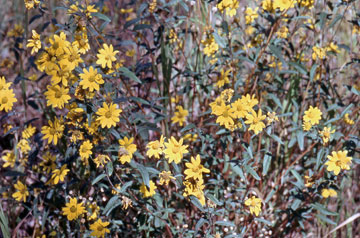 |
Tall beggar-tick, Bidens vulgata
Greene (left) grows in the southern provinces of Canada
and in most of the United States (excepting for a few in the South and
Southwest). The plant is rare in British Columbia and not particularly
common in Idaho. It grows on moist ground at least as high as the montane
zone. Bidens from the Latin means "twin-teeth" for the plants'
annoying, small, double-pointed achenes (fruit) that attach themselves
in large number to any passer-by, animal or human. The
plant may be identified by its rambling appearance, lanceolate leaves, "complete"
flower-heads with both ray- and disk-flowers, and, when fruiting, by its
"ticks."
Rayless yellow composites
Green rabbitbrush, Chrysothamnus
viscidiflorus (Hook.) Nutt. (right).
The green rabbitbrush is part of the mid- to late summer landscape
in much of the West. There are five different varieties; three grow
in Idaho. All are clustered plants with woody stems and variably hairy, narrow
green leaves. The stems, leaves and flowers often feel sticky, explaining
the name viscidiflorus. Narrow, discoid, brush-like flowers are
characteristic. Rayless composites are uncommon in the East; this may have
prompted Meriwether Lewis to collect six specimens of rabbitbrushes. |
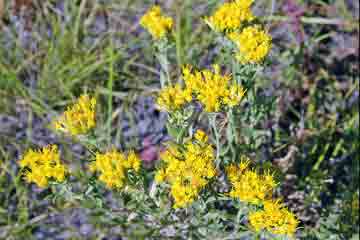 |
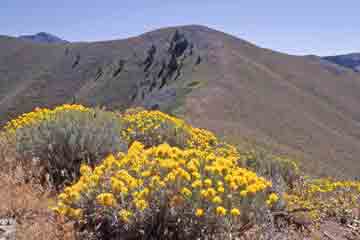 |
Rubber Rabbitbrush, Ericameria
nauseosa (Pallas ex Pursh) G. L. Nesom & G.
I. Baird (left, right). There are twenty-two varieties
of Ericameria nauseosa (formerly Chrysothamnus nauseosus).
Add several other species also known as rabbitbrushes, and one ends up with
a taxonomic jumble. We’ll consider the plant shown here as representative
and leave it at that. The rubber rabbitbrush has clusters of rayless, bright
yellow flowerheads (right), and frosted blue-green linear leaves. The sticky
latex-like sap is white, explaining the name, “rubber rabbitbrush.”
Meriwether Lewis was confused by the rabbitbrushes, the likes of which he
had never before encountered—not surprising for the plants were then
unknown to science—and he collected two specimens of this plant. A late
bloomer, the rabbitbrush adds bright late summer color to drab sage-covered
hillsides.
|
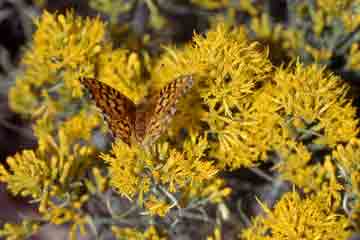 |
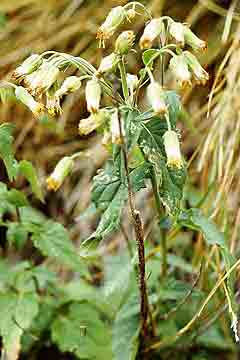 |
Large-flowered brickellia, Brickellia
grandiflora, (Hook.) Nutt. (left, right).
The brickellias grow at high elevations in our mountains and at lower elevations
elsewhere west of the Mississippi River. The plants’ pale yellow to
off-white flowerheads lack rays and appear to be squeezed together and held
in place by the involucral bracts. Prominent delta-shaped leaves also help
to identify this species. The plants bloom late, from mid-summer on. The
genus name, Brickellia, honors botanist and physician, John Brickell
(1748-1809) of Savannah, Georgia. Several similar species of brickellia are
also native to Idaho.
|
 |
Pineapple weed, Matricaria discoidea
DC. (left) Meriwether Lewis found specimens of this plant, native
to Idaho, growing along the Clearwater River on June 12, 1806. He described
it as “a small plant of an agreeable sweet scent; flowers yellow.”
The crushed plant gives off an odor close to that of a pineapple, explaining
its common name. It is a common, non-aggressive garden and border weed found
in almost every state and province.The pineapple weed grows in our mountains
on disturbed ground to mid-elevations where it blooms from mid-summer on.
The name Matricaria implies “mother-care” for its
supposed value in treating uterine conditions.
Common tansy, Tanacetum
vulgare L. Tansy (right)
is a Eurasian perennial that now grows everywhere in the Northern Hemisphere.
It is sometimes seen in Idaho at higher elevations, always near settled places.
The tansy’s button-like flowers and camphor-like odor are unique so
there will be no problem with identification. Not only is the plant ornamental,
but it is also an effective vermifuge. Tansy teas and extracts were used
medicinally for other conditions, although with some risk and questionable
benefit. Tansies also contain the insect repellant pyrethrum and their leaves
were formerly used to wrap meat to prevent spoiling, and added to winding
sheets to deter worms, supposedly explaining the derivation of
Tanacetum (and “tansy”) from the Greek athanasia,
a word that means “no death,” i.e., “immortal.” |
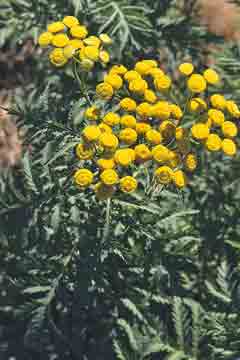 |






